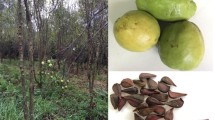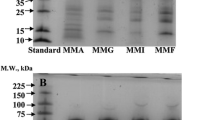Abstract
Pigeon pea protein isolates (PPI) are an option to obtain a high yield of good quality proteins and represent a great potential for the food industry. In this work, physicochemical and structural properties of albumin (ALB), globulin (GLB), and PPI obtained at different pHs (8, 9, 10, and 11) were studied to deepen the knowledge of these proteins for future application. GLB presented protein aggregates and polypeptides characteristics of 7S vicilin subunits while ALB presented polypeptides with low molecular masses. GLB showed a more compact and less flexible structure than ALB fraction due to the distinct conformational characteristics found in DSC, fluorescence spectroscopy, Ho. These structural characteristics conferred GLB greater conformational stability (∆GH2O) than ALB fraction. The latter presented a higher proportion of β-strand in aggregated structures. PPI11 showed the highest protein recovery, but the least So with more presence of protein aggregates with the least proportion of β-strands in aggregated structures. A higher percentage of protein unfolding and exposure of hydrophobic residues to solvent was observed as the extraction pH of the isolates increased. Enthalpy change of transition decreased, and the maximum emission wavelength shifted to red in fluorescence spectroscopy. However, PPI11 showed only a slight increase in Ho (10%) with respect to PPI8. The variation in pH for protein extraction constitutes a simple, rapid, and low-cost method to obtain PPI with physicochemical and structural properties that will determine its functional properties and their use as food ingredients.


Similar content being viewed by others
Abbreviations
- ALB:
-
albumin fraction
- GLB:
-
globulin fraction
- ΔH:
-
enthalpy change of transition
- FI:
-
fluorescence intensity
- ∆GH2O :
-
free energy of denaturation
- λmax :
-
maximum emission wavelength
- 2-ME:
-
2-mercaptoethanol
- MW:
-
molecular weight
- PI:
-
protein isolates
- PP:
-
pigeon pea
- PPI:
-
pigeon pea protein isolates
- SEC:
-
size exclusion chromatography
- So:
-
protein solubility
- Td:
-
denaturation temperature
- Trp:
-
Tryptophan
- V0 :
-
void volume of the column
References
FAO (2018) Legumbres. Pequeñas semillas, grandes soluciones. Ciudad de Panamá
Varshney RK, Saxena RK, Jackson SA (2017) The Pigeonpea genome. Compendium of plant genomes. Springer, Cham
Chitra U, Singh U, Rao VR (1996) Phytic acid, in vitro protein digestibility, dietary fiber, and minerals of pulses as influenced by processing methods. Plant Foods Hum Nutr 49:307–331. https://doi.org/10.1007/BF01091980
Acevedo BA, Avanza MV, Chaves MG, Ronda F (2013) Gelation, thermal and pasting properties of pigeon pea (Cajanus cajan L.), dolichos bean (Dolichos lablab L.) and jack bean (Canavalia ensiformis) flours. J Food Eng 119(1):65–71. https://doi.org/10.1016/j.jfoodeng.2013.05.014
Akande KE, Abubakar MM, Adegbola TA, Bogoro SE, Doma UD (2010) Chemical evaluation of the nutritive quality of pigeon pea Cajanus cajan L. Millsp. Int J Poultry Sci 9:63–65
Krishnan HB, Natarajan SS, Oehrle NW, Garrett WM, Darwish O (2017) Proteomic analysis of pigeon pea (Cajanus cajan) seeds reveals the accumulation of numerous stress-related proteins. J Agric Food Chem 65:4572–4581. https://doi.org/10.1021/acs.jafc.7b00998
Singh U, Jambunathan R (1982) Distribution of seed protein fractions and amino acids in different anatomical parts of chickpea (Cicer arietinum L.) and pigeonpea (Cajanus cajan L.). Plant Foods Hum Nutr 31:347–354. https://doi.org/10.1007/BF01094046
Singh U, Jambunathan R, Saxena K, Subrahmanyam N (1990) Nutritional quality evaluation of newly developed high-protein genotypes of pigeonpea (Cajanus cajan). J Sci Food Agric 50(2):201–209
Mawal Y, Mawal M, Ranjekar P (1990) Unusual denaturation properties of vicilin from Cajanus cajan. Biochem Biophys Res Commun 166(3):1446–1452. https://doi.org/10.1016/0006-291X(90)91029-R
Prema L, Kurup PA (1973) Effect of protein fractions from Cajanus cajan (redgram) and Dolichos biflorus (horsegram) on the serum, liver and aortic lipid levels in rats fed a high-fat-high-cholesterol diet. Atherosclerosis 18(3):369–377. https://doi.org/10.1016/0021-9150(73)90067-1
Shevkani K, Singh N, Kaur A, Rana JC (2015) Structural and functional characterization of kidney bean and field pea protein isolates: a comparative study. Food Hydrocoll 43:679–689. https://doi.org/10.1016/j.foodhyd.2014.07.024
Tanger C, Engel J, Kulozik U (2020) Influence of extraction conditions on the conformational alteration of pea protein extracted from pea flour. Food Hydrocoll 107:105949. https://doi.org/10.1016/j.foodhyd.2020.105949
Adenekan MK, Fadimu GJ, Odunmbaku LA, Oke EK (2017) Effect of isolation techniques on the characteristics of pigeon pea (Cajanus cajan) protein isolates. Food Sci Nutr 6:146–152. https://doi.org/10.1002/fsn3.539
Akintayo ET, Oshodi AA, Esuoso KO (1999) Effects of NaCl, ionic strength and pH on the foaming and gelation of pigeon pea (Cajanus cajan) protein concentrates. Food Chem 66:51–56. https://doi.org/10.1016/S0308-8146(98)00155-1
Mizubuti IY, Biondo Júnior O, De Oliveira Souza LW, Dos Santos Ferreira Da Silva RS, Ida EI (2000) Response surface methodology for extraction optimization of pigeon pea protein. Food Chem 70(2):259–265. https://doi.org/10.1016/S0308-8146(00)00078-9
Mwasaru MA, Muhammad K, Bakar J, Man YBC (1999a) Effects of isolation technique and conditions on the extractability, physicochemical and functional properties of pigeonpea (Cajanus cajan) and cowpea (Vigna unguiculata) protein isolates. I. Physicochemical properties. Food Chem 67(4):435–443. https://doi.org/10.1016/S0308-8146(99)00150-8
Mwasaru MA, Muhammad K, Bakar J, Man YBC (1999b) Effects of isolation technique and conditions on the extractability, physicochemical and functional properties of pigeonpea (Cajanus cajan) and cowpea (Vigna unguiculata) protein isolates. II. Functional properties. Food Chem 67(4):445–452. https://doi.org/10.1016/S0308-8146(99)00151-X
Cui L, Bandillo N, Wang Y, Ohm J-B, Chen B, Rao J (2020) Functionality and structure of yellow pea protein isolate as affected by cultivars and extraction pH. Food Hydrocoll 108:106008. https://doi.org/10.1016/j.foodhyd.2020.106008
Carbonaro M, Maselli P, Nucara A (2012) Relationship between digestibility and secondary structure of raw and thermally treated legume proteins: a Fourier transform infrared (FT-IR) spectroscopic study. Amino Acids 43(2):911–921. https://doi.org/10.1007/s00726-011-1151-4
Sun X, Ohanenye IC, Ahmed T, Udenigwe CC (2020) Microwave treatment increased protein digestibility of pigeon pea (Cajanus cajan) flour: elucidation of underlying mechanisms. Food Chem 329:127196. https://doi.org/10.1016/j.foodchem.2020.127196
Rosa MJS, Ferreira RB, Teixeira AR (2000) Storage proteins from Lathyrus sativus seeds. J Agric Food Chem 48(11):5432–5439. https://doi.org/10.1021/jf000447r
Peyrano F, Speroni F, Avanza MV (2016) Physicochemical and functional properties of cowpea protein isolate treated with temperature or high hydrostatic pressure. Innov Food Sci Emerg 33:38–46. https://doi.org/10.1016/j.ifset.2015.10.014
Quiroga A, Martínez EN, Rogniaux H, Geairon A, Añón MC (2009) Globulin-p and 11S-globulin from Amaranthus hypochondriacus: are two isoforms of the 11S-globulin. Protein J 28:457–467. https://doi.org/10.1007/s10930-009-9214-z
Fernández Sosa E, Thompson C, Chaves MG, Acevedo BA, Avanza MV (2019) Legume seeds treated by high hydrostatic pressure: effect on functional properties of flours. Food Bioprocess Technol 13(2):323–340. https://doi.org/10.1007/s11947-019-02386-9
Avanza MV, Acevedo BA, Chaves MG, Aphalo P, Añón MC (2015) Physicochemical and structural properties of major protein fractions of two varieties of NEA-cowpea (Vigna unguiculata L.): a comparative study. Int J Food Nutr Sci 4(4):240–247
Petruccelli S, Añón MC (1995) Soy protein isolate components and their interactions. J Agric Food Chem 43:1762–1767. https://doi.org/10.1021/jf00055a004
Peyrano F, de Lamballerie M, Avanza MV, Speroni F (2017) Calorimetric study of cowpea protein isolates. Effect of calcium and high hydrostatic pressure. Food Biophys 12(3):374–382. https://doi.org/10.1007/s11483-017-9493-4
Tang CH, Wang XY (2010) Physicochemical and structural characterization of globulin and albumin from common buckwheat (Fagopyrum esculentum Moench) seeds. Food Chem 121(1):119–126. https://doi.org/10.1016/j.foodchem.2009.12.016
Arntfield SD, Murray ED (1981) The influence of processing parameters on food protein functionality. I Differential scanning calorimetry as an indicator of protein denaturation. Can Inst Food Sci Technol J 14(4):289–294. https://doi.org/10.1016/S0315-5463(81)72929-8
Abugoch LE, Romero N, Tapia C, Silva J, Rivera MJ (2008) Study of some physicochemical and functional properties of quinoa (Chenopodium quinoa Willd) protein isolates. J Agric Food Chem 56:4745–4750. https://doi.org/10.1021/jf703689u
Yin SW, Tang CH, Yang XQ, Wen QB (2011) Conformational study of red kidney bean (Phaseolus vulgaris L.) protein isolate (KPI) by tryptophan fluorescence and differential scanning calorimetry. J Agric Food Chem 59(1):241–248. https://doi.org/10.1021/jf1027608
Carbonaro M, Maselli P, Nucara A (2015) Structural aspects of legume proteins and nutraceutical properties. Food Res Int 76:19–30. https://doi.org/10.1016/j.foodres.2014.11.007
Funding
The authors acknowledge the financial support from the Agencia Nacional de Promoción Científica y Tecnológica (ANPCyT) and the Universidad Nacional del Nordeste (UNNE) and CONICET, Argentina. M. V. Avanza and A. V. Quiroga are research members of the Consejo Nacional de Investigaciones Científicas y Técnicas (CONICET).
Author information
Authors and Affiliations
Corresponding author
Ethics declarations
Conflict of Interest
The authors declare that they have no conflict of interest.
Declaration of Interest
We confirm that the manuscript has been read and approved by all named authors and that there are no other persons who satisfied the criteria for authorship but are not listed. We further confirm that the order of authors listed in the manuscript has been approved by all of us.
Additional information
Publisher’s Note
Springer Nature remains neutral with regard to jurisdictional claims in published maps and institutional affiliations.
Supplementary Information
ESM 1
(DOCX 340 kb)
Rights and permissions
About this article
Cite this article
Fernández Sosa, E.I., Chaves, M.G., Quiroga, A.V. et al. Comparative Study of Structural and Physicochemical Properties of Pigeon Pea (Cajanus cajan L.) Protein Isolates and its Major Protein Fractions. Plant Foods Hum Nutr 76, 37–45 (2021). https://doi.org/10.1007/s11130-020-00871-7
Accepted:
Published:
Issue Date:
DOI: https://doi.org/10.1007/s11130-020-00871-7




